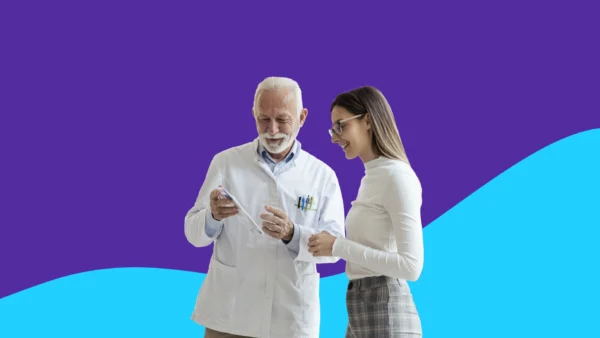GLP-1 (glucagon-like peptide-1) agonists, such as Ozempic and Wegovy, have been in the news because of their soaring popularity with celebrities for dramatic weight loss. These drugs mimic GLP-1, a hormone responsible for regulating appetite and food intake, leading to weight loss and improved control of blood sugar levels in people with Type 2 diabetes. Their usage is skyrocketing because they’re effective—for several different health conditions. So how do you know if they’re right for your patients (even those who aren’t diabetic)? These are the benefits of GLP-1 drugs, beyond blood sugar control.
Rising demand for GLP-1 drugs: Why are they so popular?
The demand for GLP-1 drugs has surged in recent years for several reasons.
- More people need treatment for obesity: The rise in obesity rates parallels the rise of GLP-1 prescriptions. The prevalence of obesity in the United States has increased from 30.5% in 1999-2000 to 41.9% in 2017-2020. The alarming increase in obesity rates heightens the need for effective weight management solutions. As a result, there is a greater demand for GLP-1 drugs like Wegovy (semaglutide), Saxenda (liraglutide), and Mounjaro (tirzepatide).
- GLP-1 drugs are effective: There is a substantial body of scientific research supporting the effectiveness of these medications for several weight-related health concerns.
- As awareness grows, patients seek out GLP-1s: Social media and direct-to-consumer advertising are also playing a role in fueling the popularity of GLP-1s. As more people become aware of these drugs and see the before-and-after evidence from people in their social media feeds and real-life friends, more people are actively seeking out these drugs as potential solutions for weight loss and health management.
Here’s what to know about the health benefits of these medications if a patient seeks your counsel.
What are the benefits of GLP-1 agonists?
GLP-1 drugs were initially developed for controlling blood sugar (glucose) levels in people with Type 2 diabetes. The drug class has become increasingly popular in recent years for its potential to aid in weight loss, but the health perks don’t stop there.
Diabetes
Blood glucose control was the first known benefit of GLP-1 drugs. Keeping blood glucose levels within a healthy range is crucial for preventing complications of diabetes, such as organ and nerve damage.
For people with diabetes, one of the critical benefits of GLP-1 agonists is their ability to lower blood sugar levels without causing hypoglycemia (low blood sugar). They do so by stimulating the release of insulin, slowing down the emptying of the stomach, and reducing the production of glucose by the liver.
If a drug is FDA approved for a particular purpose, that means the Food and Drug Administration (FDA) has deemed the drug to be effective for that purpose, based on reviewing extensive data from clinical trials supporting its use. The following GLP-1 drugs have been FDA-approved for controlling blood glucose levels in people with Type 2 diabetes:
- Byetta (exenatide)
- Bydureon (exenatide extended-release)
- Victoza (liraglutide)
- Trulicity (dulaglutide)
- Ozempic (semaglutide)
- Rybelsus (oral semaglutide)
- Tanzeum (albiglutide)
- Adlyxin (lixisenatide)
- Soliqua (insulin glargine/lixisenatide combination)
- Xultophy (insulin degludec/liraglutide combination)
In addition, the FDA has approved Mounjaro, a dual glucose-dependent insulinotropic polypeptide (GIP) and GLP-1 receptor agonist, for managing glycemic control in Type 2 diabetes. Both GIP and GLP-1 hormones are involved in regulating hunger and food intake.
Weight loss
Substantial evidence supports the efficacy of GLP-1 drugs for weight loss and weight management. Most of the research on this drug class was conducted in people with Type 2 diabetes, but has also been shown to contribute to weight loss and can be prescribed for weight management in people without diabetes.
Currently, the only GLP-1s that are FDA approved for chronic weight management in people without diabetes are Wegovy (semaglutide) and Saxenda (liraglutide)—as long as patients meet certain criteria. Adults and children 12 and older must have a BMI that qualifies as obese. Or, some adults may qualify if they are overweight and have at least one weight-related health condition. A healthcare provider may prescribe these drugs for people not meeting these criteria, but doing so would be considered off-label. If your patients are wondering if one of these drugs might be a fit, you can recommend they consult a healthcare provider.
Note that GLP-1 agonists are meant to be used along with a lower-calorie diet and increased physical activity. So, in general, your patients are more likely to have more dramatic weight loss results with a GLP-1 drug if they use it along with healthy lifestyle changes.
A 2020 clinical trial demonstrates this point. The study assessed the effectiveness of combining Saxenda (liraglutide 3 mg) with intensive behavioral therapy (IBT) for obesity. Participants were randomly assigned to receive either liraglutide or a placebo alongside IBT. The IBT for all participants consisted of regular behavioral counseling sessions, a restricted-calorie diet, and exercise, building up from 100 to 250 minutes per week. After two months, the liraglutide group had an average weight loss of 7.5%, compared to 4.0% in the placebo group. These results highlight the potential of combining a GLP-1 agonist drug with IBT to achieve substantial weight loss.
Newer GLP-1 therapies seem to be more effective than older GLP-1 agonists in reducing body weight. However, continued research is needed to understand the long-term risks and benefits better.
RELATED: What is the best diabetes drug for weight loss?
Heart failure
One of the significant benefits of GLP-1s is their positive impact on heart health. Research in people with Type 2 diabetes has shown that GLP-1 receptor agonists may lower the chances of having a heart attack, stroke, or dying from cardiovascular (heart and blood vessel) problems.
For instance, semaglutide has shown promising benefits in reducing the risk of cardiovascular events and reducing symptoms of a difficult-to-treat type of heart failure.
More specifically, a 2023 study in the New England Journal of Medicine evaluated the effectiveness of semaglutide in people with heart failure with preserved ejection fraction (HFpEF) and obesity. The study involved 529 participants who received either semaglutide or a placebo for 52 weeks. The results revealed that semaglutide led to significant improvements in heart failure symptoms, exercise ability, and weight loss compared to the placebo.
As of the time of this writing, semaglutide is not yet FDA-approved for this specific purpose.
Certain cancers
While more research is needed, GLP-1s are associated with a lower risk of certain cancers, according to studies. GLP-1s have been shown to slow the growth of cancer cells in various types of cancer, including pancreatic cancer, colorectal cancer, and breast cancer. GLP-1s have also been found to suppress tumor cell proliferation and induce cell death, thereby potentially reducing the risk of cancer development. Obesity and Type 2 diabetes are risk factors for these and other types of cancers.
Since cancer continues to be a leading cause of death and disability, this is a significant additional potential benefit of GLP-1s. This potential benefit is still being researched, and the available evidence is limited. As such, no drugs in the GLP-1 agonists class are currently FDA-approved for treating or preventing cancer.
The high cost of GLP-1 drugs
The high cost of GLP-1 drugs for weight loss remains a concern. For example, Wegovy costs around $1,349 per package of four pens, which amounts to more than $16,000 per year. Mounjaro, awaiting FDA approval for weight loss, is priced at $1,023.04 per fill.
Obesity is not consistently recognized as a medical condition across health insurance plans. As such, these drugs may not be covered by patients’ insurance. This includes Medicare and Medicaid.
The high price tag is a barrier for many people. If an insurance plan has coverage for GLP-1 drugs, it is usually limited to patients meeting strict eligibility requirements as determined by a diagnosis of Type 2 diabetes, a track record of failing multiple previous treatments, and specific body mass index (BMI) criteria––and prior authorization is typically required. Prescription savings cards such as SingleCare can help to reduce the cost.
RELATED: 4 ways to save on weight-loss medications
GLP-1 drugs have shown promise in reducing hospitalization and lowering long-term treatment costs for cardiovascular problems and weight-related conditions. As this evidence becomes more robust, more insurance plans will likely expand coverage for GLP-1 drugs in the near future.
However, due to cost concerns, some healthcare providers are prescribing GLP-1 alternatives, such as SGLT2s (sodium-glucose cotransporter 2 inhibitors), for addressing cardiovascular risk. One example is Farxiga (dapagliflozin), a brand-name drug approved to treat Type 2 diabetes and lower the risk of cardiovascular death and hospitalization in people with heart failure (when the heart is weak and cannot pump enough blood). If your patients can’t afford GLP-1s, these could be a good option.
Potential risks and side effects of GLP-1 agonists
Like most medications, GLP-1 agonists come with a list of potential side effects and precautions. While not a complete list of warnings and adverse reactions, the most common side effects of GLP-1 drugs generally include:
- Nausea and/or vomiting, which most often occur after starting the medication and typically ease with time
- Diarrhea
- Abdominal discomfort, which may be accompanied by bloating or cramping.
- Redness, swelling, itching, or pain at the injection site
Black box warning
Most GLP-1 agonist drugs carry a serious warning about the risk of thyroid cancer. These medications have caused thyroid tumors in mice and rats. It isn’t known if these drugs can cause thyroid tumors in people. As a precaution, healthcare providers may not recommend GLP-1 drugs, such as Ozempic, for people with existing risk factors, such as a personal or family history of thyroid cancer.
Bottom line—GLP-1 drugs are effective
The increased demand for GLP-1 drugs is driven by their effectiveness in weight loss and diabetes management, as well as their potential benefits on cardiovascular health. Despite the challenges posed by high costs, the popularity of GLP-1s is expected to continue to rise as more patients seek solutions for weight-related conditions.
Sources
- Adult Obesity Facts, CDC
- Liraglutide 3.0 mg and Intensive Behavioral Therapy (IBT) for Obesity in Primary Care: The SCALE IBT Randomized Controlled Trial, Obesity (2020)
- Semaglutide in Patients with Heart Failure with Preserved Ejection Fraction and Obesity, The New England Journal of Medicine (2023)
- GLP-1 Receptor Agonists: Beyond Their Pancreatic Effects, Frontiers in Endocrinology (2021)
- Wegovy: Understanding list price, NovoCare
- How much should I expect to pay for Mounjaro®?, Lilly (2023)











